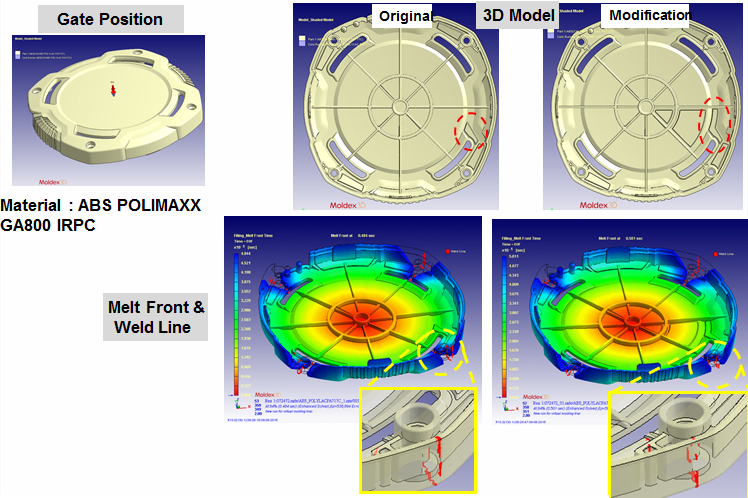- Customer: Stanley Black & Decker
- Industry: Tools manufacturing
- Solution: Moldex3D Advanced Package / Fiber / FEA Interface / Warp
- Country: USA
- View PDF Version
Stanley Black & Decker is a world-leading provider of tools and storage, commercial electronic security and engineered fastening systems, with unique growth platforms and a track record of sustained profitable growth. (Source: https://www.stanleyblackanddecker.com/)
Executive Summary
As a Project Engineer of the Design to Value (DTV) Team at Stanley Black & Decker, William Lai works with Senior Product Engineer Frank Tsai to conduct a series of projects with the help of Moldex3D. The purpose of the project is to identify the cause of the cracking problem near the screw boss where a weld line existed. Through the help of Moldex3D injection molding simulation software, they were able to precisely predict the weld line position and improve product quality. They were tasked to predict the ABS and TPE bonding temperature and molding conditions in the bi-material design hand tools through Moldex3D Multi-component Molding (MCM) over-molding simulation. They also designed the suitable injection gate shape and dimension to eliminate cold weld lines and misty surface appearance in the screwdriver handle grip product by using Moldex3D iterations of multiple process conditions. This enabled them to move the design forward to conduct structural testing and more in-depth verifications (Fig. 1).

Fig. 1 The product design process of this case
Challenges
- Cracking near the screw boss where the weld line is present
- Bi-material design causes extra cost and time delay
- The presence of cold weld line and misty surface appearance
Solutions
Using Moldex3D Advanced Package to change the weld line position, improve bonding temperature and molding conditions, and optimize gate design and core-shift value
Benefits
- Changed weld line position to pass the drop test
- Optimized molding conditions to have best ABS and TPE bonding
- Eliminated cold weld lines or misty surface appearance
- Accurate core shift value for screwdriver handle grip case
- Reduced tooling time and cost
Case Study
In order to improve the product strength and surface appearance, the team used Moldex3D to observe the behaviors of the first and second shot materials and predict the weld line positions.
In the first project, Moldex3D could accurately predict the weld line position, which is also the weak area of the product (Fig. 2). Therefore, the team could know how to modify the inner structure to change the weld line position to attain the structural strength they needed in drop test without having costly design changes during tooling phase.
 Fig. 2 By using Moldex3D, the team can predict weld line positions.
Fig. 2 By using Moldex3D, the team can predict weld line positions.
In the second project, Moldex3D shows the over-molding melt front simulation of the 1st and 2nd shot, helping users observe the bonding behavior, melt front and temperature making it possible to understand the bonding temperature conditions and further achieve the best bonding before the tooling started (Fig. 3 & Fig. 4).
 Fig. 3 Moldex3D is able to simulate the bonding behaviour of the 1st and 2nd shots.
Fig. 3 Moldex3D is able to simulate the bonding behaviour of the 1st and 2nd shots.
 Fig. 4 Moldex3D Bi-injection Module can predict that the re-melt temperature of the surface is higher than the material temperature difference when the first shot contacts the second shot. Thus, the interface of both shots is expected to be a good combination.
Fig. 4 Moldex3D Bi-injection Module can predict that the re-melt temperature of the surface is higher than the material temperature difference when the first shot contacts the second shot. Thus, the interface of both shots is expected to be a good combination.
The screwdriver handle grip is made from translucent material and has very thick cross sections. However, it is not easy to produce because cold weld lines and a misty surface appearance issue would occur (Fig. 5). Therefore, in the third project, Moldex3D was utilized to simulate multiple injection conditions using different gate designs in order to obtain the gate shape and dimension that could eliminate the cold weld line and misty surface appearance issues. As a result, they were eliminated as the plastic flowed very smoothly after the injection point was relocated (Fig. 6). In addition, the core shift value of the screwdriver metal could be accurately obtained, preventing the tooling issues.
 Fig. 5 Cold weld line and misty surface appearance issues occurred.
Fig. 5 Cold weld line and misty surface appearance issues occurred.
 Fig. 6 Cold weld lines and a misty surface were eliminated after the injection point was relocated.
Fig. 6 Cold weld lines and a misty surface were eliminated after the injection point was relocated.
After optimizing the gate shape/ dimensions and injection point to get a proper flow and core shift result through the help of Moldex3D, the team will further do the CNC sample test, EMC and EMI test, reliability test and assembly verification before the product announcement.
Results
The value of the DTV team is to drive incremental productivity and complexity reduction for the Hand Tools and Storage businesses of Stanley Black & Decker. Moldex3D has been used to simulate the plastic components and solve potential tooling or structure issues before production. This enables Stanley Black & Decker to save cost and time on product design and manufacturing, and realize the value of the DTV team.
